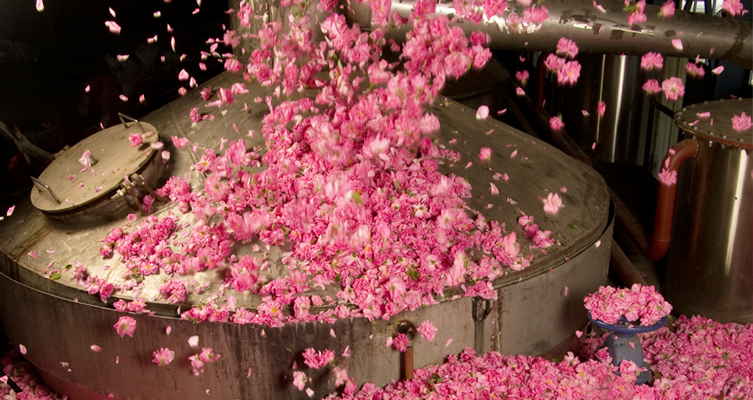- Distillation process .
- “In Bulgaria during the early 1900's, virtually all rose oil was distilled on-site using direct-fire stills operated by the farmers. A suitable site would be chosen adjacent to the field and near a stream and the apparatus would be set up. Although this sounds rather primitive, the yield produced from this type of amounts to 1 kilo of oil for every 2,500 to 3,000 kilos of roses. Amazingly, this is a considerably higher figure than can be achieved by modern industrial distillation techniques!"
- Modern stills are made of copper and are heated with an open wood fire from below. The roses can not be distilled in the usual way by directly injecting steam, because the petals compact to form a large mass that the steam can not penetrate. Therefore the distillation techniques have been refined in various ways to overcome this problem.
During distillation a large amount of oil is absorbed into the distillation water, and this is known as the 'First Water'. The rose oil must be recovered from this water to produce an acceptable yield, and this is achieved by skilfully re-distilling the water to separate the oil; a process known as cohobation. - The amount of oil produced directly from distillation is as low as only 20% or 25%, the majority being recovered from the distillate water by cohobation. This ratio does vary depending upon certain factors, but is usually in the region of 25% 'direct oil' and 75% 'water oil'. The 'Second Water' remaining after the process of cohobation is then sold as rose hydrosol (aka floral water) or re-cycled in the still for the next batch of flowers.
The total yield of oil will depend upon several conditions; climate, the time of the harvest, condition of the flowers and the method of distillation. During the middle of the harvest period the yield is higher than at the beginning, and mild weather will result in a further increase in the oil produced.
On average, Rosa damascena will yield 1 kilo of oil per 4,000 kilos of flowers using modern distillation processes. Under very favourable conditions only 2,600 kilos of roses may be required to produce 1 kilo of oil, whereas under less favourable conditions up to 8,000 kilos of flowers may be required to produce the same amount of oil.”
OUR PROCESS Our distillery. |
||
|
About Us 
|
Origins 
|
Rossana Labs 
|
